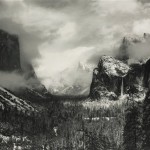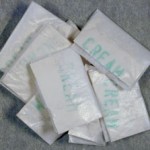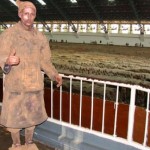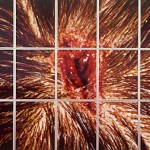“A historic sale of works by some of the biggest names in 20th-century photography set records during a two-day auction of iconic images from the Polaroid corporate collection that concluded Tuesday. The auction of more than 1,000 photographs brought in $12.4 million, exceeding its pre-sale estimate of up to $10.7 million, Sotheby’s auction house said. Fourteen new artist records were set, including ones for a photograph by Ansel Adams, by Lucas Samaras, by Andy Warhol and by Harry Callahan. Adams’ “Clearing Winter Storm, Yosemite National Park,” a moody black-and-white mural-size print of the park’s rugged, rocky terrain, sold for $722,500 on Monday. It shattered the previous auction record of $609,600 for his “Moonrise, Hernandez, New Mexico,” from 1941, set in 2006. “Clearing Winter Storm” had been estimated to sell for $300,000 to $500,000…”
Read More: Records abound at NYC Polaroid photo auction
“The empty glassine packets can be found in Manhattan, Brooklyn and beyond, scattered on streets and sidewalks with only obscure slogans or graphic images to suggest their former use. At one time they contained heroin and the markings stamped on the packets were meant to differentiate strains of varying purity or provenance. To some they are crime evidence. Addicts may see them mainly as a vehicle to fulfill a dangerous urge. For a group of artists who have been collecting them they are cultural artifacts that are equally unsettling and compelling. On Wednesday a week-long show called “Heroin Stamp Project” organized by seven members of the Social Art Collective is scheduled to open at the White Box Gallery on Broome Street on the Lower East Side. The show, which will include 150 packets picked off city streets, as well as 12 blown-up prints made from them, is meant to examine the intersection of advertising and addiction and provoke questions about how society addresses dependence and disease…”
Read More: The Art of the Potentially Deadly Deal: Marketing Heroin on the Street
“A sculpture submitted by a final-year student at the Royal College of Art has been dismantled after falling victim to health and safety rules. For his MA degree show, Pablo Wendel, 29, occupied a vacant fish and chip shop near the RCA, whose alumni include David Hockney, Bridget Riley and Tracey Emin. Wendel wanted to lead visitors to the shop by cutting down part of the London college’s fire escape, giving access to his own staircase made out of junk wood. But the German sculptor failed to carry out a risk assessment before he built his installation. As a result, the college took apart his staircase and does not intend to allow visitors into the shop where he is displaying his work, which includes old tables and chairs from the school’s furniture department…”
Read More: Royal College of Art dismantles sculpture for being a safety hazard
“It’s a fittingly peaceful end to a place that was testimony to a long and bloody conflict. The once-secret underground bunker of Marshal Tito, hidden beneath a rural house, is about to become a giant, bizarre art gallery. The bunker is in the tiny country town of Konjic, 25 miles south of Sarajevo. In the second picture below, you can see a soldier standing outside the unassuming garage door entrance to the facility. The bunker is 920 feet underground, and is designed to house 350 people for six months in the event of an attack on what was then Yugoslavia. Its long corridors are shaped like a giant U, and the 70,000 square-foot bunker is fitted out with bedrooms, generators, large food store rooms, a fresh water basin, air conditioning, and fuel tanks. It took 26 years for engineers to build it, in an effort that mirrors the magnitude of the NORAD facility in the United States, located under Cheyenne Mountain in Colorado. The engineers who built Tito’s facility also built five more, for Saddam Hussein…”
Read More: In Bosnia, Tito’s secret bunker is revealed
“Fifteen years ago Britain was declared cool again. After decades in the doldrums, a generation of British artists barely out of art school burst onto the international scene. In exhibitions such as “Brilliant! New Art from London” at the Walker Art Center in Minneapolis (1995) and “Sensation”, which travelled from London to Berlin to Brooklyn (1997-2000), they shocked audiences with their sexual imagery, the violence of some of their work, and its high visual impact. Charles Saatchi, the advertising mogul and art collector who was their earliest patron, dubbed the group of around 40—including Damien Hirst, Tracey Emin, Gary Hume, Marc Quinn, Mat Collishaw, Gavin Turk, Sarah Lucas, Jake and Dinos Chapman and the late Angus Fairhurst—the “young British artists” (YBAs) in 1997. So what has happened to their critical standing and their market now that they are middle-aged? In Australia, the Tasmanian gambling millionaire David Walsh is opening a museum in January that will display several signature pieces from “Sensation” purchased from Saatchi. These include Chris Ofili’s 1996 painting Holy Virgin Mary, Collishaw’s photographic installation Bullet Hole, 1988-93, and Jake and Dinos Chapmans’ sculpture Great Deeds Against the Dead, 1994…”
“A Paris auction house says it plans to put 12 never-before-published portraits of Michael Jackson on the block in December. The portraits were shot by French photographer Arno Bani in 1999. One of them, called “Michael Jackson’s Blue Eye,” depicts Jackson with a sad expression and a blue ring around his eye. Jackson contacted Bani, only 23 years old at the time, after seeing his fashion photography in a newspaper. Auctioneer Frederic Chambre said Tuesday that the bidding is expected to start at euro1,000 ($1,228) for each portrait. Chambre said the images could not be displayed before because of copyright issues.
Auctioneers Pierre Berge Associes will put the photos on the block, along with 50 contact boards…”
Never-before-published Michael Jackson photos to be auctioned in Paris
“AES+F’s premier in Russia of the “Feast of Trimalchio”, first shown at the 2009 Venice Biennale, is on nine massive screens and runs for 28 minutes. The work, which took three years to make, is a metaphor of “society in the post-colonial and even post-global world”, said AES+F’s Tatiana Arzamasova. “Video art is still in its infancy in Russia, but in large part that is due to the fact that contemporary art is not very developed in our country.”
Goncharenko said the history of video art in Russia began in 1985 when artists had “the chance to finally hold a video camera in their hands, and these had to be smuggled into the country”. While Russian artists increasingly see video as a powerful form of expression, they are finding almost no support from the local market, and primarily rely on international interest.
“There are great video artists in Russia such as AES+F and Olga Chernysheva, and last year we even sold one of her works to the Museum of Modern Art in New York,” said Volker Diehl, a Berlin dealer who works with Russian artists. “However, there are almost no Russian collectors or institutions really supporting and buying these video art pieces.”
Read More: Two major video art shows open in Moscow
“What links a kestrel, a zebra and the artist Lucian Freud? All have starring roles in Tim Meara’s 15-minute film, Small Gestures in Bare Rooms, on show at the Pompidou Centre in Paris. Apparently, it was the prospect of working with animals that convinced the famously reclusive Freud to appear in the film. ‘Animals for Lucian are a really big deal,’ said film-maker Meara…”
Read More: Reel art: Lucian Freud captured on film
Read More: Classic Disney Comics: Mickey Mouse Sells Amphetamine In Africa
Impenetrable art speak special: Sorry, wtf was that?
“The Synthetic Slut” filters Bjarne Melgaard’s pseudo-confessional approach to painting and materials through a patently gendered literary expression of desire, rediscovering them with the force of his own attractions and roving fascinations. Written across Bjarne’s oil paintings and the scraps of paper that he scatters and tapes on objects, voices recur, written thick and bold and without grammar. At Greene Naftali, chunks of large text in multicolored vinyl begin in the main entrance hallway floor and wallpaper the gallery, with paintings hung on top of them. Bjarne calls it a “multifunctional novel,” a neverending non-sequential epic that can be re-used and repeated, which in its compulsive longings and blunt accusations is influenced by the outlaw forms of 1980s writers Kathy Acker and Jane Delynn, who were known for inventing wild, distinctively female subjectivities…”









